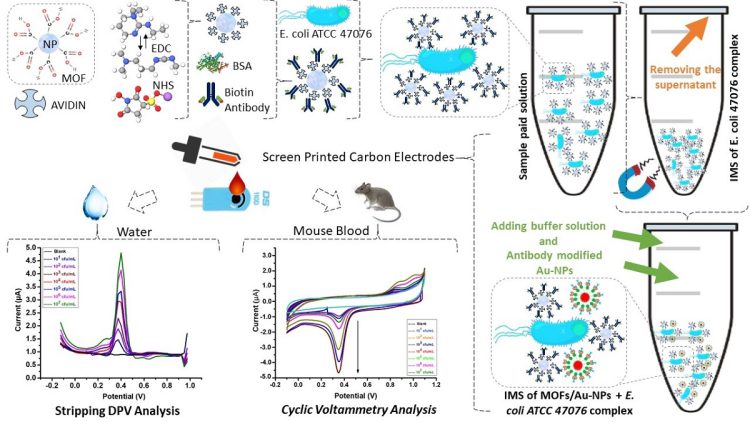Contaminated water spreads pathogenic microorganisms such as bacteria and viruses and creates the conditions for infection outbreaks. The recent COVID-19 pandemic increased the interest of the researchers around the globe in the surveillance and quantification of pathogenic bacteria and viruses in water and wastewater. Waterborne pathogens in water are growing worried throughout the world [1]. The United Nations warned about the threat of waterborne pathogens becoming global health risks for developed and under-developing countries. The rapid growth of population, industrialization, and urbanization increased the demand for safe drinking water. Safe drinking water is a need, including a fundamental human right [2]. Pakistan is at the vulnerable risk of waterborne-pathogen bacteria, and the water contamination issue is a daily highlight on social media. Pakistan is facing many water contamination problems. It has been reported that about 50 percent of all diseases and 40 percent of death causes are occurring in Pakistan due to low water quality and waterborne diseases. Pakistan is paying half of its total health budget for the cure of waterborne diseases. This budget can be easily saved if our government provides safe drinking water to the people. Unfortunately, the health problems are going from bad to worse, and the number of deaths is increasing every year due to cause by waterborne diseases. According to water experts, every year in all provinces, over 100,000 people, half of them children, died from waterborne diseases in Pakistan [4]. However, this country is practicing plating counting method and importing a biosensor on the heavy amount for the detection of waterborne pathogens from water and blood. These techniques are not reliable, time-consuming and less sensitive. Additionally, conventional laboratory-based method is inadequate for effective on-site water quality monitoring purposes. Thus, the electrochemical biosensor has achieved profound development due to their easy handling, portable, tunable morphology, high compatibility, and offered quick sensing response for the capturing of pathogens.
Additionally, electrochemical nano-biosensors could sustain the matrix effects of the physiological specimen and offer detection of bacteria in water and blood samples. Moreover, gold nanoparticles present fast and direct electron transfer among several electroactive species. The negative surface charge of gold nanoparticles was conjugated with positively charges antibodies for the detection of E. coli bacteria in water. citrate capped gold nanoparticles were modified with a specific biotinylated antibody for the detection of targeted E. coli pathogens in water [5]. Amongst the various nanomaterials, magnetite metal-organic frameworks (MOFs) are receiving attention because of their large specific surface area, easy to separate, high porosity, and diversity in structures. MOFs are a porous crystalline material made of metal ions corresponding to organic legends. Magnetite iron oxide nanoparticles (Fe3O4) can be separated easily from the liquid reaction by a user of an external magnetic field due to the combination of MOFs [6].
Detection of E. coli ATCC 47076 mechanisms
In this study, a screen-printed electrode served as a dispersible electrode platform was employed for enumerate of E. coli from the multiple complex samples. The sandwich complex was obtained in a solution phase after the interaction of E. coli with magnetic metal organic frameworks (MOFs) and mercaptoundecanoic acid (MUA) modified gold nanoparticles (AuNPs). The resulting sandwich complexes interacted for 0.5 h; then, a permanent magnet was used to collect the complex samples. To obtain electrochemical signals from the resulting multiple complex samples, we dropped a 10 µl of PBS buffer solution (pH 7.2) on the surface of SPCE to cover the entire surface area of electrode to analyze the bare electrode with one cycle from -0.1V to 1.0 V at a scan rate of 100 mV/s. Then, MOFs-Ab-E. coli -Ab-MUA-AuNP sandwich complex was added on the surface of the electrode. The stripping differential plus voltammetry (SDPV) was recorded to detect the various concentrations of the sandwich complex for SDPV measurement. The oxidation peak observed for the sandwich complex modified electrode in the presence of (0.1 M) HCl. The oxidation peak current linearly increased (Fig. 2). Therefore, these results proposed that MOFs-Ab-E. coli -Ab-MUA-AuNP sandwich complex improved the sensitivity and catalytic activities after using HCl. The surface of the SPC electrode to oxidize the gold (0) to gold (III) by using HCl. However, the detection performance was investigated using various concentrations of E. coli from 101-107 CFU/mL. The electrochemical performance of various concentrations of bacteria as conjugated with antibody modified AuNPs were added at the surface of the SPC electrode to examine the electrochemical potential. Each concentration was repeated thrice. The relationship between various paid concentrations of selected bacteria and the signal to noise ratio (SNR) was linear (R2 = 0.992). The SNR was analyzed and compared with the peak current of conjugated nanoparticles to each concentration of E. coli. The results of various concentrations of the targeted E. coli revealed a linear relationship between the different concentrations of E. coli and the SNR of 101, 102, 103, 104, 105, 106, 107 CFU/mL and received current as the 0.809, 1.101, 1.351, 1.789, 3.133, 3.946, 4.665 microamperes (µA), respectively. The proposed approach is effective as compared to earlier reported approaches. The limit of detection (LOD) was observed thrice, the repetition of the lowest current (0.809 µA) at the lowest concentration of 101 CFU/mL with the calculation of standard deviation (SD). Then, it was calculated thrice for repeated signals of SD σ = 0.0042 and an equation of LOD with three times of SD formula (For example., 3 × σ)/m). Where m is the measured slope (0.992) of the calibration curve, and the calculated results depicted a limited deviation. Therefore, the linear relationship was found at 101-107 CFU /mL for a fast response time of 5 min using developed biosensor with an R2 of 0.992 and an LOD of 0.012 CFU /mL for the detection of targeted E. coli ATCC 47076.
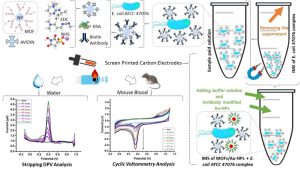
Detection of E. coli ATCC 47076 in mouse blood
The potential of the developed nano-dispersible electrode was investigated to the real to life condition by testing and inoculated targeted bacteria into the mouse blood sample. The MOF-Ab-E. coli ATCC 47076 -AuNPs sandwich complex was added on the surface of the SPCE related to potentiostat for electrochemical analysis. The cyclic voltammetry (CV) technique was employed and recorded with PBS from -0.2 to 1.2 V at a scan rate of 100 mV/s. Initially, 5µl of buffer solution was added at the SPCE for the measure of bare of the electrode. Then, the CV sensorgram detection of E. coli from blood sample was analyzed by linearly increased the different concentrations of the sandwich complex as, 101, 102, 103, 104, 105, 106, 107 CFU/ml. The received signals of all concentrations were 9.86, 11.14, 13.36, 17.80, 32.11, 40.92, and 46.68 microamperes (µA). As revealed in (Fig. 3), a well-presented redox peak was investigated of the sandwich complex functionalized SPCE in the presence of 0.1 M HCl, which indicates the free elections transfer reaction. The reduction peak current was increased clearly, while the signals of oxidation peak current reduced. However, these results demonstrated that MOF-Ab-E. coli ATCC 47076-AuNPs sandwich complex improves the catalytic activity and sensitivity after using HCl. However, the linear relationship was found at 101-107 CFU /mL using developed dispersible electrode with an acceptable logarithmic linearity (0.921), this was obtained for the detection of E. coli ATCC 47076 form the mouse blood. For further explanation the scheme of detection mechanism of both detection modes (DPV and CV) is exposed in (Fig. 1).
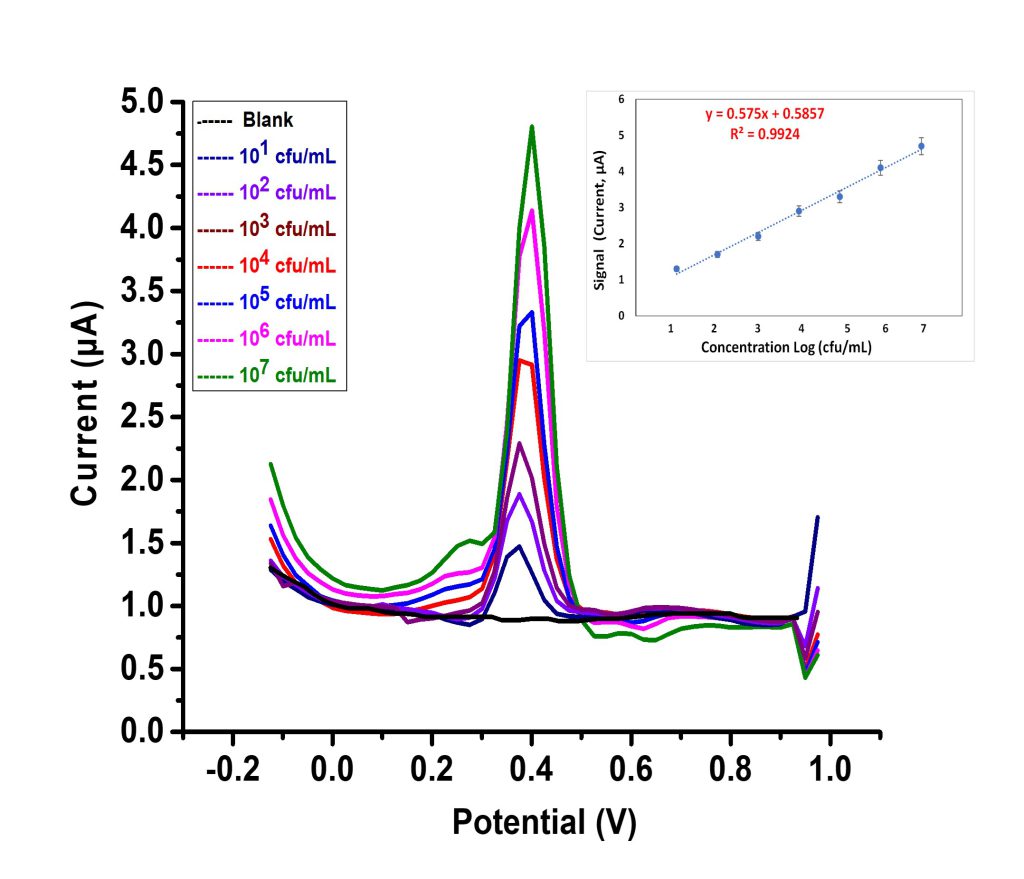
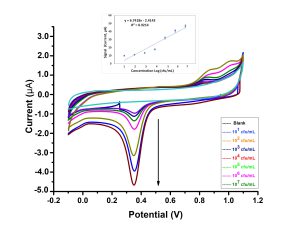
The following advantages were observed in this study:
- Dual mode detection
- Dynamic Detection range
- Sensitive and Selective
- Short time detection
The developed dispersible sensor is capable for the capturing of pathogens E. coli ATCC 46076 based on dual mode detection as stripping differential pulse voltammetry and cyclic voltammetry measurements with a dynamic detection range from 101 to 107 CFU/mL. The dispersible electrode offered an advantage such as high sensitivity, selectivity, and short analysis time (5 min). According to previous reported work, we have first time displayed the novel research using of potential materials as AuNPs and MOFs nanoparticles for the modification of dispersible electrode for the capturing of targeted E. coli from water and blood.
SEM imaging technique also used for the interaction of antibody functionalized magnetic MOFs nanoparticles and E. coli as shown in (Fig. 4). Moreover, the proposed dispersible electrode offered a sensitive, selective, reliable, economical, and rapid identification method.
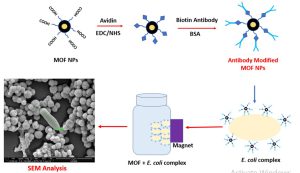
The proposed method could have a potential application in the rapid detection of pathogenic bacteria in real samples, and this technology could be commercialized. The environmental protection agency and other health departments are executive agency of government of Pakistan have lot of opportunities to promote this current technology in concerned health institutes. The multifunctional immunoassay-based sensor MOFs-Ab-E. coli-MUA-labeled-AuNP-Ab offered powerful separating and detecting of the targeted bacteria and is promising platform material for the sensitive identification of specific bacteria in various forms of samples as presented in figure Such types of devices could play a crucial role in the clinical diagnosis, food analysis and environmental measurement in the future.
The Stripping DPV and CV techniques, combined with sandwich-type multiple complexes, provided a lower LOD value compared with the other approaches reported in the literature (Table 1).
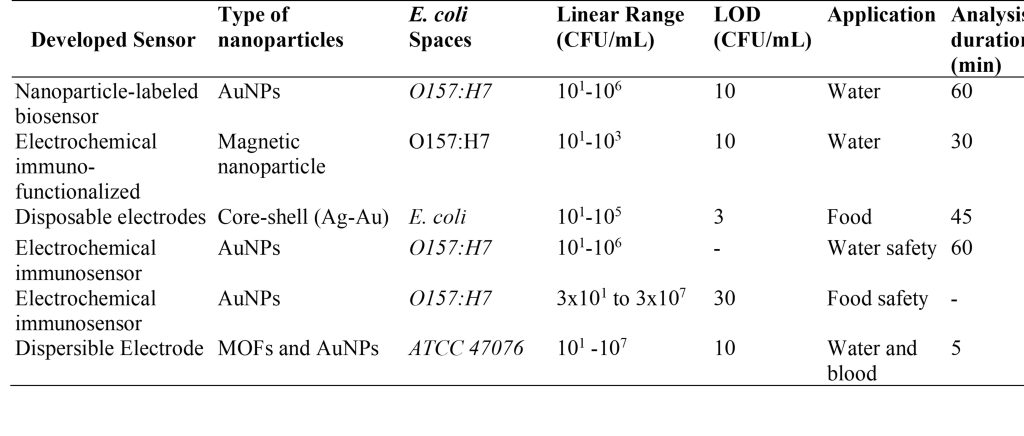
The author is an Assistant Professor in the Department of Civil Engineering, National University of Sciences and Technology (NUST), Balochistan Campus Quetta and can be reached at [email protected].
Researcher’s Profile: https://bit.ly/3OvUVvB

